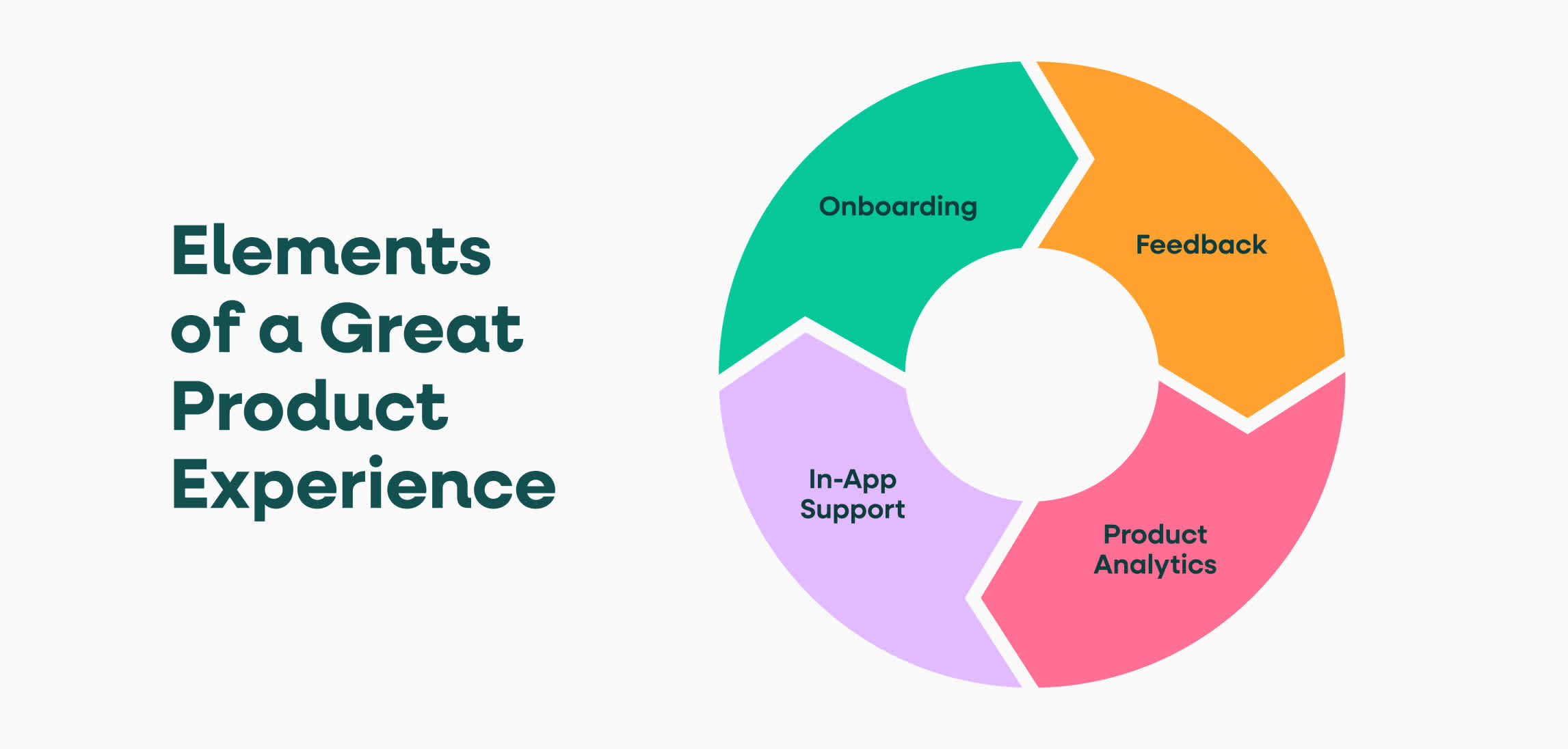When was the last time you used a product that made you think, “Wow, they really get me”?
That feeling of seamless interaction, thoughtful design, and intuitive functionality isn’t an accident—it’s the result of a carefully crafted product experience (PX).
Great products do more than serve a purpose—they create experiences that feel intuitive and rewarding. When a product anticipates user needs and removes friction, it becomes something users can’t imagine living without.
In this guide, we’ll explore proven strategies to fine-tune your PX, ensuring your customers don’t just use your product—they love it.
Quick takeaways
Product experience focuses on the entire customer journey, while user experience (UX) hones in on usability and specific touchpoints, making both critical for long-term success.
The stakes of poor PX are high, with 86% of consumers leaving a brand after two bad experiences and 90% abandoning apps due to performance issues.
A great product experience relies on four pillars: effective onboarding, actionable customer feedback, behavioral analytics, and contextual in-app guidance.
Behavioral data uncovers hidden friction points in the customer journey, helping teams optimize workflows and improve satisfaction.
Understanding product experience
What keeps customers coming back to a product—and telling everyone they know about it? It’s not just what the product does; it’s how it makes them feel.
Product experience is the complete journey a customer has with a product, covering every interaction from first use to ongoing engagement. Unlike general user experience (UX), PX zeroes in on how the product feels, functions, and delivers value within the customer’s journey.
And loyalty isn’t just about features—it’s built on how a product supports and delights its users. In fact, 96% of customers stay loyal to brands that offer great service, proving that experience often outweighs functionality when it comes to long-term success.
To truly understand PX, think big: map the entire customer journey. From the first trial to renewal, every interaction shapes how customers see and feel about your product.
Product experience vs. user experience
At first glance, product and user experience (UX) may seem interchangeable, but they address different aspects of how customers interact with and perceive a product.
What they have in common
Both PX and UX aim to improve how users engage with a product. They focus on creating seamless and enjoyable experiences that meet user needs and expectations. Both are essential for building products that users love.
Key differences
Scope: PX is the bigger picture—it’s the customer’s overall journey with the product, encompassing every interaction from onboarding to support. UX, by contrast, zooms in on specific features, design elements, and usability during individual interactions.
Focus: PX measures success over time, considering how the product integrates into a customer’s life or workflow. UX focuses on the immediacy of individual touchpoints—how easy, intuitive, or satisfying a single task feels.
Inclusion: PX includes external factors like customer support, surrounding services, and long-term engagement. UX is narrower, dealing primarily with usability, accessibility, and feature design within the product itself.
Both experiences are critical to a product’s success. UX lays the foundation for great usability, while PX drives long-term satisfaction and loyalty by addressing the holistic customer journey.
Why product experience matters across industries
Across industries, product experience is the foundation for trust and loyalty. However, the stakes are high: 86% of consumers will leave a brand after just two poor experiences.
Let’s explore how PX impacts key sectors and why it’s critical for long-term success.
Technology and SaaS
The technology and SaaS industry thrives on innovation, but even minor performance issues can be costly. Studies show that 90% of users abandon an app due to poor performance, highlighting the importance of delivering seamless, reliable experiences to retain users.”
Smooth onboarding processes help users quickly grasp value.
Intuitive design reduces support tickets and increases retention.
Proactive support fosters trust and deepens user relationships.
E-commerce and retail
In e-commerce, where competition is fierce, PX is what turns casual browsers into loyal customers. A personalized shopping experience can mean the difference between a sale and an abandoned cart.
Optimized checkout flows reduce friction and improve conversion rates.
Personalization tools drive higher customer satisfaction and repeat purchases.
Frustration-free navigation keeps customers engaged and lowers bounce rates.
Finance and insurance
Finance and insurance customers expect secure, user-friendly platforms to handle sensitive tasks. PX makes complex actions—like managing accounts or applying for policies—feel effortless.
Streamlined interfaces simplify otherwise complicated workflows.
Clear, accessible information builds customer confidence.
Robust error prevention minimizes user frustration and churn.
Healthcare
In healthcare, PX impacts not just satisfaction but outcomes. A well-designed experience empowers patients and professionals to access information and services when they need them most.
Intuitive portals enhance appointment scheduling and records access.
Accessible design improves experiences for patients with varying needs.
Frictionless navigation ensures critical data is always within reach.
Travel and hospitality
The travel and hospitality industry relies on PX to create memorable, stress-free experiences. From the moment a customer books to the time they check out, PX shapes their journey.
Frictionless booking processes increase trust and conversion rates.
Real-time updates keep travelers informed and confident.
Personalized recommendations elevate satisfaction and loyalty.
From ecommerce to healthcare, the principles of a great PX remain the same, even as the products themselves vary widely. Whether you’re optimizing a digital shopping cart, a patient portal, or a travel booking system, a thoughtful PX ensures users feel valued and supported at every step.
Let’s break down the core elements that make this possible, no matter the industry.

4 elements of a great product experience
A positive product experience is essential for earning customer satisfaction and loyalty. Whether it’s a retail platform, banking app, or healthcare portal, the same foundational elements create an experience that not only meets expectations but exceeds them.
In fact, 74% of consumers are at least somewhat likely to make purchasing decisions based solely on their experience with a product. This underscores just how vital PX is for driving loyalty and boosting revenue.
Each element builds upon the other, forming a roadmap to a truly exceptional PX:
1. User onboarding: Start the journey right
Onboarding is the first impression your product makes. A streamlined and thoughtful onboarding process sets the tone for the entire customer journey, ensuring users can quickly and confidently engage with your product.
Welcome surveys: Capture user preferences to deliver tailored experiences from the start.
Guided walkthroughs: Use tooltips and step-by-step guides to familiarize users with essential features.
Streamlined processes: Minimize steps to reduce frustration and boost early engagement.
Effective onboarding ensures users see value quickly, reducing the risk of churn before they even get started.
2. Customer feedback: Learn from your users
Your customers hold the key to continuous improvement. Collecting feedback ensures your product evolves to meet their needs and stay ahead of expectations.
Surveys and reviews: Identify strengths and pain points directly from your users.
Feedback reminders: Use well-timed prompts to maximize responses and uncover actionable insights.
Exit feedback: Learn why users leave to refine your product and address potential issues.
Feedback is a two-way street—it builds trust with your users while guiding your product roadmap.
3. Product analytics: Understand behavior at scale
Great PX is built on understanding what works and what doesn’t. Product analytics tools empower product teams to make data-driven decisions, ensuring products remain relevant and impactful.
Usage insights: Discover which features resonate with users—and which don’t.
Real-time metrics: Quickly identify pain points to optimize the experience.
Behavioral data: Analyze patterns to refine workflows and anticipate user needs.
Analytics bridge the gap between intuition and evidence, keeping your product aligned with user expectations.
4. Contextual in-app guides: Support users when it matters most
Even the best-designed products benefit from a guiding hand. Contextual in-app guides provide support exactly where and when users need it, turning potential confusion into confidence.
Prompts and tips: Simplify complex workflows with intuitive guidance.
Feature discoverability: Highlight hidden tools to enhance the user experience.
Ongoing support: Reduce the learning curve and foster long-term engagement.
While these core elements lay the foundation for an exceptional product experience, the next step is understanding how to bring them to life through actionable strategies that make a tangible impact.
5 ways to improve customer product experience
Improving product experience isn’t just about fixing what’s broken—it’s about creating an environment where users feel supported, engaged, and empowered every step of the way. Here’s how you can take actionable steps to elevate PX, no matter your product or industry:
1. Add an in-app resource center
Your users should never have to guess where to find help. An in-app resource hub puts guidance front and center, offering tutorials, FAQs, and support options right when users need them.
What this looks like in action: Imagine a banking app with a “Help & Learn” tab that offers quick how-tos on setting up payments, troubleshooting login issues, or understanding interest rates.
How to start: Use behavioral data to identify areas where users often get stuck and create tailored resources that address their specific challenges.
2. Create a user-driven product community
A product isn’t just a tool—it’s part of a broader experience. Building a community allows users to connect, share insights, and learn from one another while reinforcing their relationship with your brand.
What this looks like in action: A fitness app could feature a community board where users share workout tips, post progress photos, or offer advice on using specific features.
How to start: Launch a discussion forum or integrate community features directly into your product to foster engagement and collaboration.
3. Use customer feedback for targeted improvements
Feedback is a goldmine of product experience insights—but only if you act on it. Regularly collecting and analyzing user feedback can pinpoint areas to improve and validate the changes you make.
What this looks like in action: A SaaS platform might use in-app surveys to ask, “What’s one feature you’d like us to improve?” Feedback like this not only shows users you care but provides actionable data for updates.
How to start: Set up surveys or feedback prompts that target specific parts of the user journey, such as post-onboarding or after feature launches.
4. Highlight new features with in-app walkthroughs
Even the best features can go unnoticed if users don’t know they exist. Contextual walkthroughs and guides introduce users to updates in a way that feels natural and useful.
What this looks like in action: A streaming platform could use tooltips to highlight a new “Watch Party” feature, showing users exactly how to use it within seconds.
How to start: Plan feature rollouts with guided tours that pop up the first time users encounter new functionality. Keep instructions brief and focused.
5. Prioritize human-centered support
When users feel stuck, they need fast, reliable help. Whether it’s a chatbot, live chat, or email support, providing assistance that’s timely and empathetic can turn negative experiences into positive ones.
What this looks like in action: A travel booking app offering 24/7 live chat for immediate rebooking assistance when users miss a flight.
How to start: Use analytics to identify common support requests and ensure your helpdesk or chatbot solutions are equipped to handle them proactively.
How to measure product experience effectively
Now that we’ve explored strategies to improve product experience, the next step is understanding how to measure its impact. Effective measurement identifies what’s working, what needs adjustment, and where to focus next. Use these approaches to ensure your product consistently delivers value:
1. Track key performance indicators (KPIs)
KPIs provide a high-level view of your product’s performance. Focus on metrics that matter:
Net Promoter Score (NPS): Indicates user loyalty and likelihood to recommend.
Feature adoption rates: Show how well users engage with specific features.
Churn rates and error rates: Highlight areas causing dissatisfaction.
Usage metrics: Include session duration, frequency, and active users.
Use these KPIs alongside behavioral data to understand how interactions align with user needs and expectations.
2. Analyze customer journey data
Mapping the customer journey reveals where users encounter friction or disengage.
Identify common drop-off points in workflows or funnels.
Spot recurring frustration signals like rage clicks or abandonment.
Prioritize fixes for the touchpoints that have the biggest impact on user satisfaction.
Regularly revisiting journey data ensures your product evolves with user behavior.
3. Leverage customer feedback
User feedback adds depth to the data. Gather insights with:
Surveys: Collect opinions post-interaction to uncover pain points.
In-app prompts: Ask targeted questions about specific features or moments.
Exit surveys: Understand why users leave to address churn causes.
Combine feedback with analytics to validate patterns and prioritize updates.
By focusing on these areas, you’ll create a continuous loop of insight and improvement, ensuring your product stays aligned with user needs.
Are you capturing everything you need to enhance your product experience?
Enhancing PX isn’t just about meeting expectations—it’s about creating moments that delight, engage, and keep your customers coming back. From frictionless onboarding to actionable product analytics and tailored in-app guidance, every interaction counts.
But here’s the real question: Are you seeing the full picture? Without comprehensive behavioral data, critical insights could be slipping through the cracks. Fullstory’s advanced product analytics and behavioral data tools ensure you’re not just guessing—you’re making data-driven decisions to optimize every touchpoint.
Don’t let blind spots hold your product back. Take the next step toward building a truly exceptional PX. Learn more about how Fullstory can help you capture everything.



